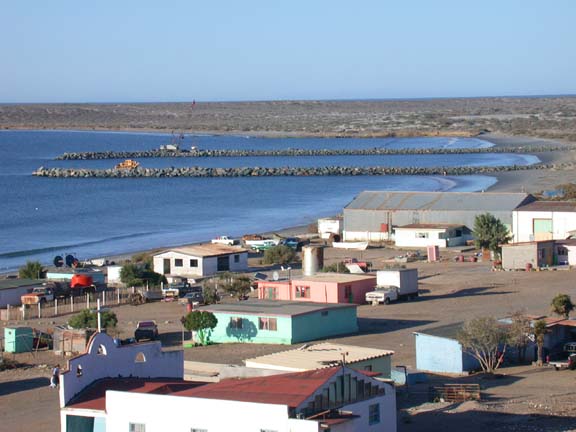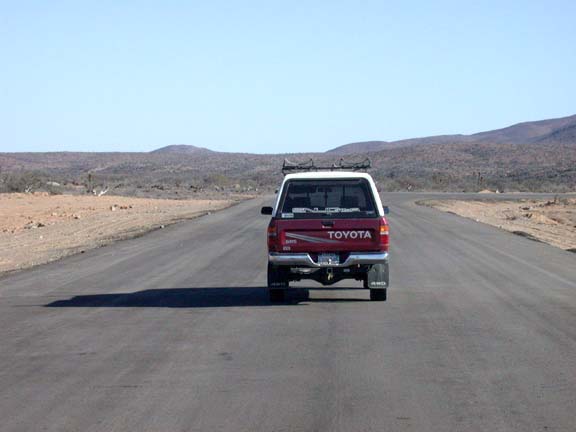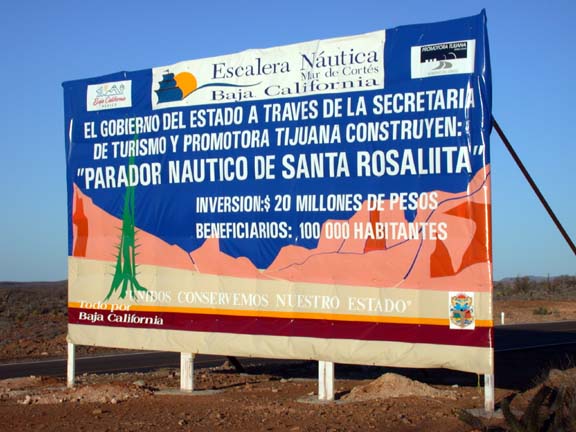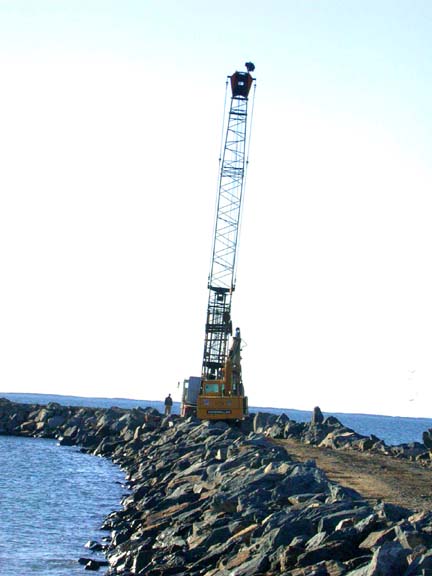
Escalera Nautica: Mexico's Stairs to Nowhere
![]()
|
At Santa Rosalillita, work progresses on the western terminus of the overland boat route to Bahia de los Angeles, Baja California, Mexico. |
SANTA ROSALILLITA HAS THE BEST ROAD OF ANY FISH CAMP IN BAJA
By Gene Kira, June 15, 2002, as orginally published in Western Outdoor News:
One of the strangest new sights along Baja's Transpeninsular Highway can be found about 50 miles north of the famous whale lagoons of Guerrero Negro.
Here, in a particularly bare and lonely stretch of desert foothills, is the turnoff for a ten-mile side road leading to the Pacific Ocean and the hardscrabble fishing village of Santa Rosalillita (Santa Rosa-li-yee'-ta).
|
|
Nothing remarkable about that. As you drive down the Baja peninsula, there are dozens of dirt roads that have been bulldozed off Mex 1 to the Pacific and Sea of Cortez coasts. Some of these roads are long, some are short, and some are little more than goat tracks, but they all end up in fish camps or villages that would be hard for a newcomer to distinguish from Santa Rosalillita.
What is remarkable about Santa Rosalillita's road is that it is paved, with beautiful, smooth blacktop, and it is wide, amigos, very, very wide. At nearly 40 feet wide (I recently paced it off at 38 feet), Santa Rosalillita's road is about twice as wide as Mex 1 itself. It is the widest and most beautiful fish camp road that Baja--and maybe the whole world--has ever seen. This thing is so wide you want to look over your shoulder to make sure there isn't a B-52 or 747 on final approach.
When this marvel was still being graded, I figured one of the earth-moving contractors had made a simple mistake: "Eh, Juanito! Are we supposed to read this stupid map in meters, or feet?"
But, no mistaking it, work proceeded. The unbelievably wide roadbed soon extended over the horizon, and even more astonishingly, it was paved from side to side with new blacktop. On my last trip down Mex 1, I couldn't resist trying this amazingly deluxe access into Santa Rosalillita. I turned onto the new road and joyously pressed the pedal to the metal, anticipating ten miles of super-weird flying to the coast.
|
The side road to Santa Rosalillita is paved for 2.7 miles of its 10-mile length. It is twice as wide as Mex 1 itself. |
But, only 2.7 miles off Mex 1, the blacktop ended as though chopped off by a guillotine blade, and we were back to the same narrow, washboard, rocky road as always. It was a Baja super-highway to nowhere.
Eventually, this road's mysterious story was explained by an impressive billboard erected at the turnoff, which declared that the new blacktop was part of the Escalera Nautica, or Nautical Stairway, Mexico's $1.9 billion (correct, that's a "b" in front of the "-illion") scheme to attract tourists by building a chain of 24 marinas--from Ensenada, all the way around Baja California, and down the Mexican mainland to about Mazatlan.
This plan calls for the federal government to contribute $200 million in seed money, intended to attract another $1.7 billion in private investment, to expand or create airports, roads, and marinas at: Ensenada, Cabo Colonet, Punta Canoas, Santa Rosalillita, Bahia Tortugas, Punta Abreojos, San Juanico, Puerto San Carlos, Los Cabos, La Paz, Loreto, Mulege, Santa Rosalia, Bahia de los Angeles, Bahia San Luis Gonzaga, San Felipe, Puerto Penasco, Bahia Kino, Guaymas, Huatabampo, Topolobampo, Altata, Mazatlan, and Teacapan.
|
|
Also included in the plan are: 17,000 hotel rooms, 34 golf courses, and most importantly, a spectacular, 12-meter wide "land bridge" road, for boats up to 55 feet long, that will carry them overland from Santa Rosalillita on the Pacific Ocean to Bahia de los Angeles on the Sea of Cortez (more later).
Regardless of what ecological disasters a mega-project of such proportions might inflict upon the delicate coastal desert environment, the business model of the Escalera Nautica seems doomed by some insurmountable shortcomings.
The goal of the Escalera Nautica--according to Mexico's tourism development agency, FONATUR--is to bring 61,000 boats over 16 feet long and 860,000 high-end tourists annually to Baja and the Sea of Cortez by the year 2014. This would be a 700 percent increase over the current figure of about 8,600 boats annually--to be achieved within 12 years.
Where will all this eye-popping growth come from?
FONATUR hopes for a tremendous explosion in the percentage of U.S. boaters who travel south. Using FONATUR's figures, about 1.6% of qualified western-U.S. boats now travel to Baja California or the Sea of Cortez. By 2014, that percentage must jump to about 7%, if FONATUR's goal is to be reached.
Why should so many Americans change their habits and switch to Mexico?
In addition to ecotourism, one of the major attractions is anticipated to be golf, in emulation of the Los Cabos glamour-golf boom miracle. Alejandro Rodriguez Mirelles of FONATUR was recently quoted by Sandra Dibble in the San Diego Union, as saying: "Golfers...spend a lot, $200 to $250 per green fee, and they don't worry about the cost of the hotel. That's the kind of person that we want."
FONATUR hopes that a chain of 22 marinas will attract big numbers of cruising boats over 30 feet long, bringing many free-spending golfers to fill the hotels and restaurants.
Unfortunately, however, very few golfers will come by boat, simply because there aren't enough boats to carry them. By FONATUR's estimate, along the entire West Coast of the U.S. there are only about 85,000 marina slips, holding boats of all sizes. Therefore, even if every qualified cruising boat went down the Escalera Nautica every year, the 61,000-boat quota would probably never even be approached.
At present, according to FONATUR, about 80% of all boats visiting Baja California and the Sea of Cortez are trailer boats. Because of the limited availability of larger boats, this trend will continue indefinitely.
|
The sign at the turnoff to Santa Rosalillita. Printed on plastic, it was in shreds by February of 2003. |
Trailer boats could cruise the Escalera Nautica's 24 ports only with effort, during limited seasons, and with an average of only about 3 people aboard. They are to be provided improved roads to launch points only at Ensenada, Puerto Penasco, Kino Bay, and San Carlos. Even so, if 61,000 boats came per year, we're still only looking at perhaps 250,000 tourist visits annually--nowhere near the 860,000 needed to support the Escalera Nautica's infrastructure.
Oops! There goes the spreadsheet and a few dozen high-rise hotels.
Anyway you slice it, a bunch of trailer boaters are not going to support the galaxy of luxury "world class" resorts proposed by FONATUR. High-end tourism, as clearly demonstrated by Cancun and the Los Cabos Corridor, is a fly-in business. Interestingly, in FONATUR's plan there is only the briefest, peripheral mention of sport fishing, RV parks, beach camping, and other typical trailer boat accommodations. In FONATUR's vision, trailer boaters will be expected to stay in hotels--and play golf. Uh huh.
But, to see the best example of the Escalera Nautica's haphazard planning process, you can drive down Mex 1 and visit the super-wide, ludicrously truncated "land bridge" road at Santa Rosalillita.
Here, boats not "circumnavigating" Baja are supposed to cruise down the Pacific coast to this point, cross the peninsula on enormous trailers, and relaunch at Bahia de los Angeles on the Cortez side.
That's a daringly ingenious idea, something like the Panama canal, but the underlying logic is again, slightly loco.
If only one-quarter of FONATUR's envisioned 61,000 boats per year choose this shortcut to visit and return from the Sea of Cortez, a boat would have to be pulled out of the water about every five minutes at either Santa Rosalillita or L.A. Bay, 12 hours per day, during peak seasons. Assuming a minimum of 8 hours to cross the peninsula with these monsters, about 100 giant, hydraulic-jack trailer rigs would have to work continuously to keep the system going.
Surely, this would be a fantastic service for boats larger than, say, 28 feet that are too big to trailer down Baja easily.
But, if most of the Escalera Nautica's customers have smaller trailer boats, under 26 feet, how many of them will choose to cruise hundreds of miles to Santa Rosalillita, and then pay big bucks for this Escalera Nautica hauling service?
Wouldn't it be a lot cheaper and much easier simply to trailer directly to a launch ramp on the Sea of Cortez and launch there? And--most critically--aren't most of the trailer boaters who really want to visit the Sea of Cortez already doing so?
But, all that doesn't really seem to be the point. If the Escalera Nautica project is ever actually pursued, it's main effect will most likely be the wasteful funneling of government money into a few pockets. Some profitable construction contracts will be let, a few rocks will be moved, some grandiose arches will be erected, some sad marinas will be half-built, and when the dust settles, we'll be left with a few more curious artifacts, baking in the desert sun--just like the road to Santa Rosalillita.
|
Work at Santa Rosalillita. If completed, this marina will require constant dredging to keep it open. |
(Related Baja California, Mexico, articles and reports may be found at Mexfish.com's main Baja California information page. See weekly fishing news, photos, and reports from the major sportfishing vacation areas of Mexico including the Baja California area in "Mexico Fishing News.")
MEXICO FISHING INFO BAJA FISHING INFO "WEEKLY MEXICO FISHING NEWS" FISH PHOTO GALLERY



